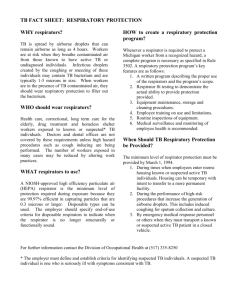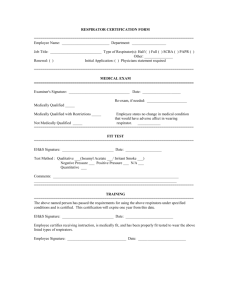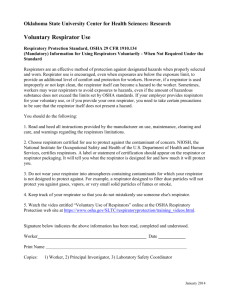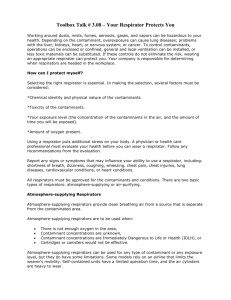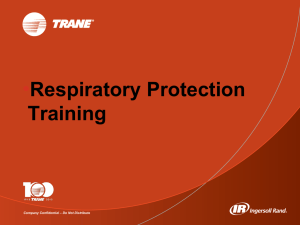Respiratory Protection
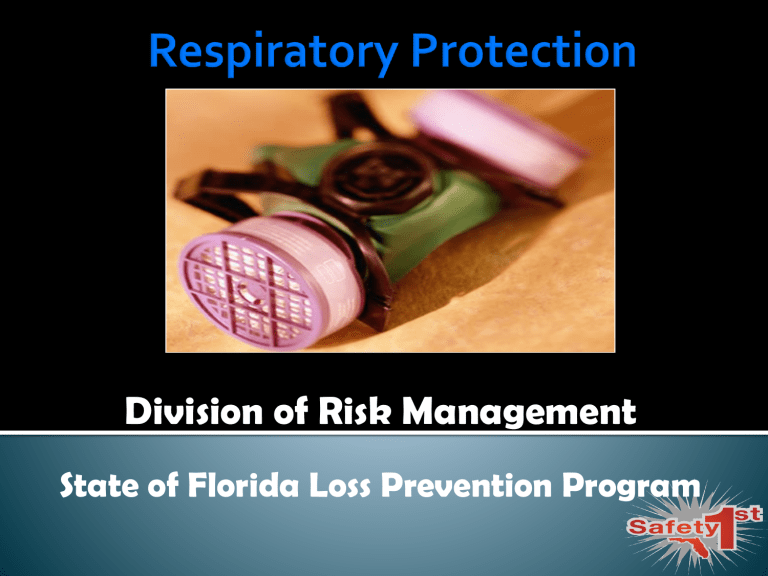
Division of Risk Management
State of Florida Loss Prevention Program
You will be able to:
Identify the hazards of airborne contaminants.
Identify and use appropriate respiratory protection.
Recognize the limitations and capabilities of respirators in our workplace.
Inspect, maintain, and store respirators.
Use respirators under dangerous or emergency conditions.
Understand procedures for medical evaluations and recognize the medical signs and symptoms that may prevent effective respirator use.
Locations where respirators are required.
Types of airborne contaminants.
Airborne particles:
▪ Dust, fog, smoke, fume, mist, aerosol.
Chemical vapor or gas.
Biological organisms:
▪ Bacteria, mold, spores, fungi, or viruses.
Lack of adequate oxygen.
Immediately dangerous to life or health (IDLH) atmosphere.
Oxygen deficiency is an example of IDLH.
IDLH conditions occur in confined spaces, large chemical spills, or chemical fires.
Protect with a full face-piece supplied-air respirator (SAR) with self-contained air, or selfcontained breathing apparatus (SCBA).
Standby person must be trained to conduct emergency rescue.
Prevent inhalation of airborne contaminants.
Generate negative pressure in face piece.
Generate positive pressure in face piece.
Air is passed through a filter, sorbent, or catalyst that traps contaminants.
When other controls are inadequate or not feasible.
During installation of engineering controls.
During maintenance operations.
While performing non-routine tasks.
For emergency response.
Tight-fitting
Straps or clamps.
Half face, full face, or mouthpiece.
Dust mask (durable or single-use).
Loose-fitting
Hood or helmet.
The minimum level of protection of a properly functioning respirator.
APF 10 means one-tenth of the airborne contaminant filtered by the respirator may be inhaled.
Each type of respirator must have an APF for each contaminant it filters.
APRs are negative pressure.
Simply filter the air, not supply oxygen.
Particulate.
Gas and vapor.
Combination.
Limited to non-IDLH atmospheres, maximum APF of 50.
Maximum APF of 10.
No protection for the face or eyes.
Sight is not impaired, and no need for corrective lenses.
Not as heavy as full face respirator.
Maximum APF of 50.
Protects the face and eyes.
Difficult to see when the face piece fogs up.
Difficult to speak.
Requires lens correction.
Maximum APF 25 to 1,000.
A blower forces ambient air through filter.
No separate or self-contained air supply.
IDLH atmosphere, including oxygen-deficient.
Unknown airborne contaminants.
Contaminants with poorly understood exposure limits or other warnings.
Specific chemicals.
Contaminant concentrations exceed maximum use concentration (MUC) limits.
MUC=The OSHA Permissible Exposure Limit
(PEL) x APF.
Provides a separate or self-contained air supply from outside the ambient atmosphere:
▪ SAR.
▪ SCBA.
Primary types are continuous flow, demand, and pressure demand.
Negative pressure.
Filter removes particulates (dust):
▪ The filter is an integral part of the mask.
▪ The entire mask is composed of the filter material.
Hazard protection is very limited.
Image Credit: OSHA
It is intended only for emergency exit.
Used mainly for IDLH atmospheres.
Any questions about the hazards of airborne contaminants at our facility?
The types of respirators used at the facility?
The physical state of the contaminants.
Contaminant concentration.
Oxygen deficiency.
Warning properties of the contaminant(s).
Potential for an IDLH atmosphere.
Length of time of respirator use.
The workload of the wearer.
The working environment (e.g., temperature).
The proper filter media for the given contaminant.
Potential hazard of skin contact with contaminants.
Potential hazard of eye contact with contaminants.
If cartridges have no “end-of-service-life indicator,” a change schedule must be used.
Added table for oxygen-deficient atmospheres based on altitude.
All must be labeled and color-coded with the
NIOSH approval label.
The label must not be removed and must remain legible.
Marked with “NIOSH,” manufacturer’s name and part number, and cartridge or filter type.
Matrix approval label supplied.
“End-of-service-life” indicator (ESLI) must be
NIOSH-certified for APRs.
Acid gas (e.g., sulfuric acid)—white.
Acid gas and organic vapor—yellow.
Acid, ammonia, and organic vapors—brown.
Acid gas, ammonia, carbon monoxide, and organic vapors—red.
Ammonia—green.
Carbon monoxide gas—blue.
Chlorine—white and yellow.
Dust, fumes, and mists
(non-radioactive)—orange.
Organic vapor—black.
Other vapors and gases—olive.
Required for any tight-fitting face piece before use.
Ensures no contaminants leak into the face piece.
Retesting required annually, and after weight loss or dental work.
No beards allowed.
Negative pressure test for APRs
▪ Exposure less than 10 times the exposure limit.
PAPRs and atmosphere-supplying in negative pressure mode.
Subjective—smell or taste
▪ Irritant smoke and ambient aerosol.
Numeric measurement— fit factor—of leakage into the respirator:
▪ Controlled negative pressure.
▪ Portacount.
For negative-pressure
APRs, exposure levels greater than 10 times the occupational exposure limit.
No facial hair or glasses are allowed that prevent a tight seal.
The face piece seal is paramount.
Perform a seal check each time you put on the respirator.
Conduct a positive and negative pressure check.
You can use your own respirator if it does not create a hazard.
Read the information for voluntary users of respirators.
Program for non-required users.
No program required if only dust masks are used.
Inspect the respirator before each use and during cleaning, following manufacturer’s instructions.
Emergency respirators:
▪ Check at least monthly when not in use.
▪ Check before and after each use.
Check elastic parts for pliability and deterioration.
Report any problems or defects.
Toss out dust masks.
Remove filters.
Wash and rinse.
Carefully replace valves.
Dry with cloth or air dry.
Reassemble, then test.
Protect equipment from damage, sunlight, or contamination.
Store dry respirator and cartridges in a clean container or bag.
Do not allow the face piece to be distorted.
Any questions about your responsibilities for the care and use of respirators and their components?
Any questions about the respiratory protection plan or dangerous atmospheres?
An initial medical evaluation—a questionnaire— is required before fit testing and respirator use.
All medical evaluations must be confidential.
Employees must be allowed to discuss the questionnaire with the physician.
Follow-up evaluations must be conducted if conditions of use or user health change.
29 CFR 1910.134:
▪ Requires a written respiratory protection plan.
▪ Employee training.
▪ Medical evaluation.
▪ Fit testing.
▪ Provide respirators at no cost to employee.
Use NIOSH-approved respirators only.
Evaluate the workplace hazards.
Select respirators from multiple models and sizes.
Where exposure to hazards can’t be estimated, consider it as
IDLH.
Written operating procedures:
▪ Respirator selection, use, training, and fitting.
▪ Respirator maintenance, storage, and inspection.
▪ Work area surveillance.
Medical examinations.
Program evaluation.
Must be site specific.
Must have a program administrator.
Worker applying trichloroethane in a confined space.
Half-face respirator.
Becomes unconscious.
List the hazards.
What are the proper safety procedures to prevent exposure?
Understand the physical and health hazards of dangerous airborne substances in your work area.
Make sure appropriate engineering controls are implemented before using a respirator.
Know how to properly don, fit, use, inspect, clean, and store respirators.
Inspect respirators and cartridges before each use.
Always make sure the right respirator and cartridge are matched to the appropriate working conditions and contaminants.
For more information on this subject, please contact:
Division of Risk Management
State of Florida Loss Prevention Program
StateLossPreventionProgram@myfloridacfo.com
(850)413-4756
